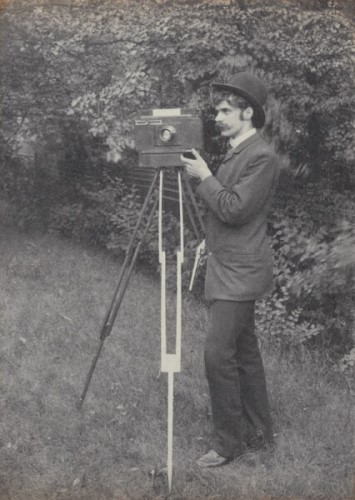Introduction
Sarah Greenough

Alfred Stieglitz, Self-Portrait, Freienwalde a. O., 1886, platinum print, National Gallery of Art, Washington, Alfred Stieglitz Collection, 1949.3.9
Key Set number 12
Alfred Stieglitz was a superb photographer who mastered many different methods of making negatives and prints. He was trained in Berlin in the 1880s by noted photochemist Hermann Wilhelm Vogel. Stieglitz applied the rigorous scientific discipline he learned under Vogel to his photographic practice throughout his life. As he tested his skills in the 1880s and 1890s, he wrote many articles in German, British, and American photographic journals detailing his experiments with different photographic processes. Although he published few technical articles after 1900, he nevertheless continued to explore a wide variety of photographic materials and technical developments. His writings, along with scientific analysis of his prints, provide insight into his extensive experimentation and the ways in which he sought to perfect his art.
Throughout his career, Stieglitz used large-format cameras that took 3 1/4 × 4 1/4-, 4 × 5-, and 8 × 10-inch black-and-white negatives. Although his early negatives were made on glass plates, around the turn of the twentieth century he switched to film, which had become widely available. Both kinds of negatives are coated with a gelatin emulsion made light-sensitive with silver salts. After exposure in a camera, the plates or film are developed and fixed, forming a negative image consisting of silver metal particles. In the 1890s and early 1900s, Stieglitz frequently enlarged his negatives; after 1910 he made contact prints the same size as the negative.
Soon after he began making photographs, Stieglitz became entranced with the recently introduced platinum paper. Throughout the 1890s, as he sought to secure his position as one of the leading photographers of his time, he explored a wide variety of printing methods, including carbon, gum bichromate, and photogravure. These processes allowed him to make enlarged prints from his negatives, which he believed at the time to be better suited for exhibitions. Like many other photographers of the period, he also made numerous lantern slides in the 1890s, which he exhibited in annual photographic salons. In 1907, when the color Autochrome process was invented, he utilized it, while in the mid-1910s, as platinum became more expensive, he made both palladium and silver-platinum prints. Beginning in the early 1920s, he started to use gelatin silver photographic paper, which he continued to employ until he stopped making photographs in 1937.